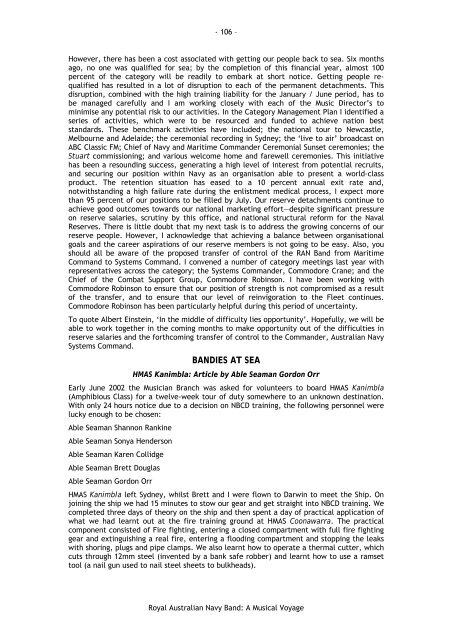A MUSICAL VOYAGE - Royal Australian Navy
A MUSICAL VOYAGE - Royal Australian Navy
A MUSICAL VOYAGE - Royal Australian Navy
Create successful ePaper yourself
Turn your PDF publications into a flip-book with our unique Google optimized e-Paper software.
- 106 –<br />
However, there has been a cost associated with getting our people back to sea. Six months<br />
ago, no one was qualified for sea; by the completion of this financial year, almost 100<br />
percent of the category will be readily to embark at short notice. Getting people requalified<br />
has resulted in a lot of disruption to each of the permanent detachments. This<br />
disruption, combined with the high training liability for the January / June period, has to<br />
be managed carefully and I am working closely with each of the Music Director’s to<br />
minimise any potential risk to our activities. In the Category Management Plan I identified a<br />
series of activities, which were to be resourced and funded to achieve nation best<br />
standards. These benchmark activities have included; the national tour to Newcastle,<br />
Melbourne and Adelaide; the ceremonial recording in Sydney; the ‘live to air’ broadcast on<br />
ABC Classic FM; Chief of <strong>Navy</strong> and Maritime Commander Ceremonial Sunset ceremonies; the<br />
Stuart commissioning; and various welcome home and farewell ceremonies. This initiative<br />
has been a resounding success, generating a high level of interest from potential recruits,<br />
and securing our position within <strong>Navy</strong> as an organisation able to present a world-class<br />
product. The retention situation has eased to a 10 percent annual exit rate and,<br />
notwithstanding a high failure rate during the enlistment medical process, I expect more<br />
than 95 percent of our positions to be filled by July. Our reserve detachments continue to<br />
achieve good outcomes towards our national marketing effort—despite significant pressure<br />
on reserve salaries, scrutiny by this office, and national structural reform for the Naval<br />
Reserves. There is little doubt that my next task is to address the growing concerns of our<br />
reserve people. However, I acknowledge that achieving a balance between organisational<br />
goals and the career aspirations of our reserve members is not going to be easy. Also, you<br />
should all be aware of the proposed transfer of control of the RAN Band from Maritime<br />
Command to Systems Command. I convened a number of category meetings last year with<br />
representatives across the category; the Systems Commander, Commodore Crane; and the<br />
Chief of the Combat Support Group, Commodore Robinson. I have been working with<br />
Commodore Robinson to ensure that our position of strength is not compromised as a result<br />
of the transfer, and to ensure that our level of reinvigoration to the Fleet continues.<br />
Commodore Robinson has been particularly helpful during this period of uncertainty.<br />
To quote Albert Einstein, ‘In the middle of difficulty lies opportunity’. Hopefully, we will be<br />
able to work together in the coming months to make opportunity out of the difficulties in<br />
reserve salaries and the forthcoming transfer of control to the Commander, <strong>Australian</strong> <strong>Navy</strong><br />
Systems Command.<br />
BANDIES AT SEA<br />
HMAS Kanimbla: Article by Able Seaman Gordon Orr<br />
Early June 2002 the Musician Branch was asked for volunteers to board HMAS Kanimbla<br />
(Amphibious Class) for a twelve-week tour of duty somewhere to an unknown destination.<br />
With only 24 hours notice due to a decision on NBCD training, the following personnel were<br />
lucky enough to be chosen:<br />
Able Seaman Shannon Rankine<br />
Able Seaman Sonya Henderson<br />
Able Seaman Karen Collidge<br />
Able Seaman Brett Douglas<br />
Able Seaman Gordon Orr<br />
HMAS Kanimbla left Sydney, whilst Brett and I were flown to Darwin to meet the Ship. On<br />
joining the ship we had 15 minutes to stow our gear and get straight into NBCD training. We<br />
completed three days of theory on the ship and then spent a day of practical application of<br />
what we had learnt out at the fire training ground at HMAS Coonawarra. The practical<br />
component consisted of Fire fighting, entering a closed compartment with full fire fighting<br />
gear and extinguishing a real fire, entering a flooding compartment and stopping the leaks<br />
with shoring, plugs and pipe clamps. We also learnt how to operate a thermal cutter, which<br />
cuts through 12mm steel (invented by a bank safe robber) and learnt how to use a ramset<br />
tool (a nail gun used to nail steel sheets to bulkheads).<br />
<strong>Royal</strong> <strong>Australian</strong> <strong>Navy</strong> Band: A Musical Voyage

















